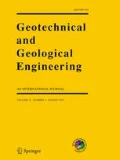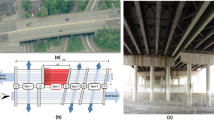Abstract
Over fifty percent of our nation’s 560,000-plus bridges are obsolete or structurally deficient. To upgrade or replace these structures would require a serious budget. In order to shorten this list of bridges and to improve their ratings, state DOTs are investigating new repair techniques and better performance evaluation tools in order to implement the new drive to sustainability within the infrastructure. The research presented herein focused on the evaluation of current US bridge analysis and rating procedures for the North Carolina Department of Transportation (NCDOT). To evaluate these procedures, several bridges were rated with commercially available software and a newly developed spreadsheet program. In parallel, the bridges were also load tested for comparison, from which, it was concluded that the NCDOT’s bridge rating software directly follows the latest AASHTO requirements. The experimental results, however, also proved that the bridges had significant strength reserves associated to several factors, such as, girder/deck composite action, impact and distribution factors, material strength, and contribution of non-structural elements. In this research, a simplified bridge testing protocol was developed from which it was concluded, that a relatively simple instrumentation setup could be effective in the load rating of bridges through testing. The data gathered through these instruments provide vital performance data for normal traffic conditions, as well as during extreme loading conditions and evacuations, which could lead to less restrictive load ratings and removal of the structurally deficient classification, yielding a more sustainable structure.


Similar content being viewed by others
References
American Association of State Highway and Transportation Officials (2000) Manual for condition evaluation of bridges, second edition (revised by 1995–2000 Interim Revisions). Washington
Beal DB (1998) Manual for bridge rating through load testing. Research Results Digest. Number 234. Nov 1998
Gergely J, Lawrence TO, Prado CL, Ritter CT, Stiller WB (2004) Evaluation of bridge analysis vis-à-vis performance. North Carolina Department of Transportation Research Project No. HWY-2002-12, Final Report
National Bridge Inventory (2003) http://www.nationalbridgeinventory.com
Stallings JM, Yoo CH (1993) Tests and ratings of short span steel bridges. J Struct Eng ASCE 119(7)
Vanderzee PJ (2005) A bridge too near. Bridges Mag 8(1):18–21
Acknowledgments
The North Carolina Department of Transportation and the Federal Highway Administration’s Innovative Bridge Research and Construction program sponsored the research documented in this report. The authors would like to thank the Division 10 Bridge Maintenance Unit for their technical and material assistance throughout the project. The authors would also like to thank Concrete Supply of Charlotte, NC, which provided the use of their truck to load two of the bridges, Vulcraft of Florence, SC, which supplied the work platform for one of the bridges, Zapata Engineering of Charlotte, NC, which provided additional instruments to the last two bridge tests. Thanks are also extended to AASHTOWare for the use of the demonstration programs. Their contributions are greatly appreciated.
Author information
Authors and Affiliations
Corresponding author
Rights and permissions
About this article
Cite this article
Lawrence, T.O., Ritter, C.T. & Gergely, J. Bridge Monitoring and Performance Evaluation. Geotech Geol Eng 29, 919–926 (2011). https://doi.org/10.1007/s10706-010-9365-x
Received:
Accepted:
Published:
Issue Date:
DOI: https://doi.org/10.1007/s10706-010-9365-x




